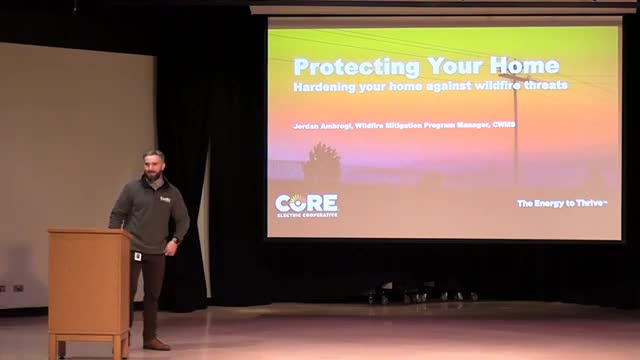Experts urge home hardening and plant choices to reduce wildfire ignition risk
February 01, 2025 | Conifer, Jefferson County, Colorado
This article was created by AI summarizing key points discussed. AI makes mistakes, so for full details and context, please refer to the video of the full meeting. Please report any errors so we can fix them. Report an error »

Jordan Brogene, wildfire mitigation program manager for Core Electric, and Marilyn Salzman, a community presenter, addressed home hardening, ember hazards and plant choices at the Conifer Area Council meeting Feb. 20.
Brogene summarized that most catastrophic home losses during wildfires are driven by embers or firebrands and framed mitigation around the "home ignition zone" — the structure and the 0–5 foot immediate area and the 5–30 foot intermediate zone around a house. He advised low‑cost mitigations: keep roofs and gutters free of leaf litter and pine needles; install metal flashing at roof‑to‑wall junctions to prevent ember accumulation against wood siding; screen gaps and vents with 1/8‑inch metal mesh; remove highly flammable plants such as juniper; use noncombustible or low‑combustibility landscaping within 5 feet of the foundation (fine gravel and low‑burning succulents); and avoid storing firewood adjacent to the house.
Brogene noted the relative performance of window assemblies (double‑paned tempered glass in metal frames preferred over single pane in wood frames) and reminded residents that porches and decks are part of the home and should be kept clear of combustibles. He offered OARS (Core Electric) brochures for residents seeking assessments.
Marilyn Salzman pointed attendees to IdahoFireWise.org for plant rankings and summarized characteristics of more fire‑resistant plants — low oil/resin content, high moisture content, compact growth habit and drought tolerance. She recommended removing juniper and suggested native Rocky Mountain perennials and succulents as lower‑risk landscaping choices; she also listed Master Gardener events in June where residents can learn more.
Nut Graf: Presenters emphasized that embers, not direct flame contact alone, drive most home ignitions; inexpensive, targeted actions around the roof, vents, foundation and immediate landscaping can materially reduce ignition potential.
Additional details: Brogene said 8–90% (transcribed range) of destroyed homes are ignited by embers and emphasized the 0–5 foot immediate zone as the highest priority for mitigation. He recommended 1/8‑inch metal mesh for vents per NFPA guidance. Salzman recommended the Idaho Firewise plant list and noted local Master Gardener events to learn about low‑probability gardens.
Ending: Brogene and Salzman said printed brochures and local resources would be available after the meeting and encouraged homeowners to inspect attic/roof gaps, clear gutters, screen vents and reconsider landscaping immediately adjacent to structures.
Brogene summarized that most catastrophic home losses during wildfires are driven by embers or firebrands and framed mitigation around the "home ignition zone" — the structure and the 0–5 foot immediate area and the 5–30 foot intermediate zone around a house. He advised low‑cost mitigations: keep roofs and gutters free of leaf litter and pine needles; install metal flashing at roof‑to‑wall junctions to prevent ember accumulation against wood siding; screen gaps and vents with 1/8‑inch metal mesh; remove highly flammable plants such as juniper; use noncombustible or low‑combustibility landscaping within 5 feet of the foundation (fine gravel and low‑burning succulents); and avoid storing firewood adjacent to the house.
Brogene noted the relative performance of window assemblies (double‑paned tempered glass in metal frames preferred over single pane in wood frames) and reminded residents that porches and decks are part of the home and should be kept clear of combustibles. He offered OARS (Core Electric) brochures for residents seeking assessments.
Marilyn Salzman pointed attendees to IdahoFireWise.org for plant rankings and summarized characteristics of more fire‑resistant plants — low oil/resin content, high moisture content, compact growth habit and drought tolerance. She recommended removing juniper and suggested native Rocky Mountain perennials and succulents as lower‑risk landscaping choices; she also listed Master Gardener events in June where residents can learn more.
Nut Graf: Presenters emphasized that embers, not direct flame contact alone, drive most home ignitions; inexpensive, targeted actions around the roof, vents, foundation and immediate landscaping can materially reduce ignition potential.
Additional details: Brogene said 8–90% (transcribed range) of destroyed homes are ignited by embers and emphasized the 0–5 foot immediate zone as the highest priority for mitigation. He recommended 1/8‑inch metal mesh for vents per NFPA guidance. Salzman recommended the Idaho Firewise plant list and noted local Master Gardener events to learn about low‑probability gardens.
Ending: Brogene and Salzman said printed brochures and local resources would be available after the meeting and encouraged homeowners to inspect attic/roof gaps, clear gutters, screen vents and reconsider landscaping immediately adjacent to structures.
View full meeting
This article is based on a recent meeting—watch the full video and explore the complete transcript for deeper insights into the discussion.
View full meeting
